In Which I Also Can’t Figure Out Why I Enjoyed This Movie…
“After the Show” is our spoiler-friendly way of talking about movies at ZekeFilm. In this article, plot twists and hidden details of Hail, Caesar! are potentially discussed.
DIRECTORS: JOEL AND ETHAN COEN/2016
 Well, here we go, folks: Hail, Caesar! For the Coen Brothers’ latest cinematic sleight-of-hand, Jim Tudor very astutely wonders in his review “just who this film is really for” and I left the opening day matinee showing wondering exactly the same thing. Part Hollywood Babylon-type movie lore — everything from James Dean’s dentures to the sexual peccadilloes of “sophisticated” movie directors like George Cukor and Mitchell Leisen — mixed with cultural and political paranoia circa 1950 make for references so obscure and jokes so “in” that I wondered who except serious film scholars, or those obsessed with, say, Roy Rogers Westerns, could possibly “get” it all.
Well, here we go, folks: Hail, Caesar! For the Coen Brothers’ latest cinematic sleight-of-hand, Jim Tudor very astutely wonders in his review “just who this film is really for” and I left the opening day matinee showing wondering exactly the same thing. Part Hollywood Babylon-type movie lore — everything from James Dean’s dentures to the sexual peccadilloes of “sophisticated” movie directors like George Cukor and Mitchell Leisen — mixed with cultural and political paranoia circa 1950 make for references so obscure and jokes so “in” that I wondered who except serious film scholars, or those obsessed with, say, Roy Rogers Westerns, could possibly “get” it all.
Certainly not the busload of retirement home folks I happened to see the film with! Five minutes before the curtain drew in the 83-capacity AMC theater, two hospital attendants ushered in about a dozen elderly people who slowly-but-eagerly filed into the front rows as the lights went down. After the showing, I heard one white-haired dear turn to her friend and say, “Well, that was quite interesting, but I’m not sure I understood everything.” No doubt she and others in her group had perhaps seen the original films explicitly recreated for the film, such as On the Town (1949) or Neptune’s Daughter (1949), back in the day – or movies very much like them – and for these old folks to be nonplussed by Hail, Caesar!‘s intended references across both movie history and Old Hollywood gossip-mongering is possibly saying a good deal.
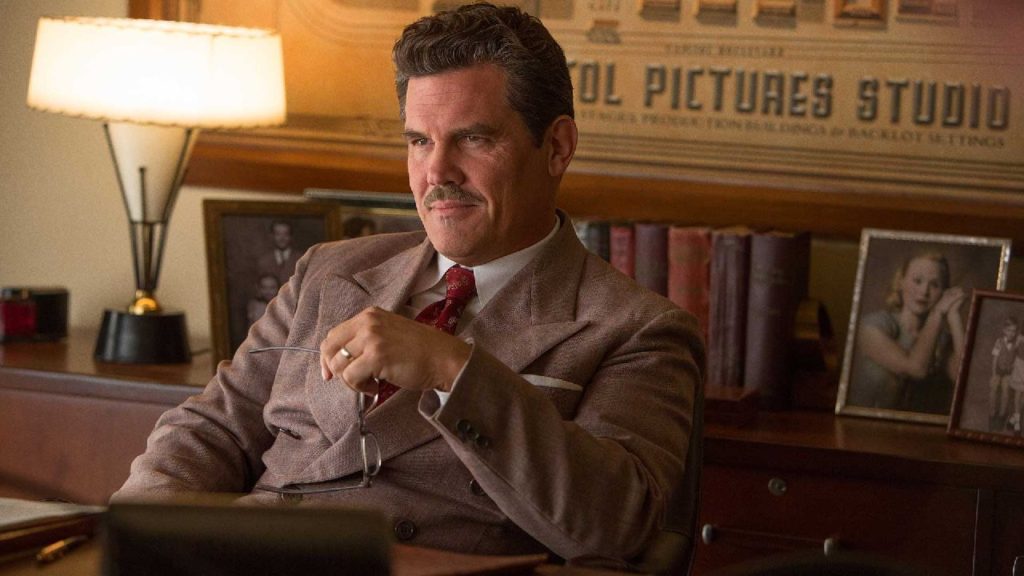
…
But we’re getting a bit ahead of ourselves, I fear. Whether it’s the Depression-era South, the Southwest of the mid-80s, Texas in the early 80s (twice, actually), or lazy L.A. in the early 90s – most recently, it was the Greenwich village folk scene of the early 60s – no one evokes time and place in movie terms quite as well as the Coen Brothers. As to what they are “evoking” in Hail, Caesar!, it’s Hollywood in the early 50s as the classic studio system is quickly collapsing. In the story of studio “fixer” Eddie Mannix’s (Josh Brolin) fruitless attempts to keep fictional studio Capitol Pictures afloat through scandal, impending ruin, and increasing competition from television (not to mention Communist “subversion” and Armageddon courtesy of the atomic bomb), the Coens’ intended audience (whomever that might or might not be) is treated to a merry melange of colorful figures and situations drawn from real Hollywood history – as filtered through the movie lens of the brothers’ delirious imaginations.
Just from the trailer, I assumed the film – along with its title – to be at least partially based on Rex Harrison’s drunken behavior on the set of Cleopatra (1963), but, if so, the fact that Hail, Caesar! is set a full decade earlier, and that George Clooney’s cluelessly loutish “Baird Whitlock” seems a good deal more affable than the famously acidic Harrison, I would be inclined to think MGM’s 1951 Technicolor production of Quo Vadis to be a more suitable candidate and the stolid actor-idiot in question to be a more suitable stand-in for Quo Vadis star Robert Taylor.
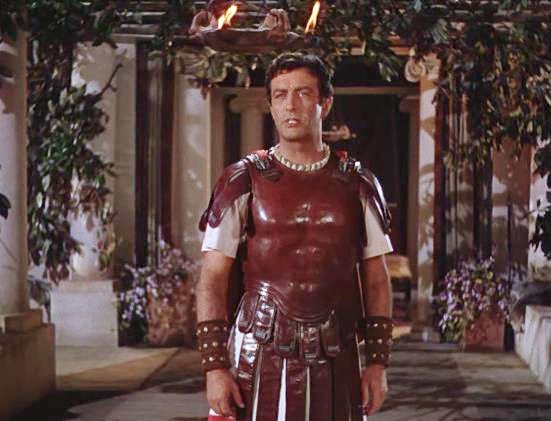
Robert Taylor in Quo Vadis (1951)
ALSO! Going a bit further down the rabbit hole of Coen Brothers-related arcanery, there is the consideration of the Coens’ previous Hollywood satire, 1991’s Barton Fink, set in the early 40s. Also (also) set at the fictional Capitol Pictures, the story of a left-leaning New York playwright’s disturbingly surreal travails as a Hollywood hack scripting a “wrestling picture with Wallace Beery” is covertly referenced in Hail, Caesar! where glossy 8X10s of the beefy actor wistfully adorn studio conference rooms curiously lacking the big-name producers who once held court there.
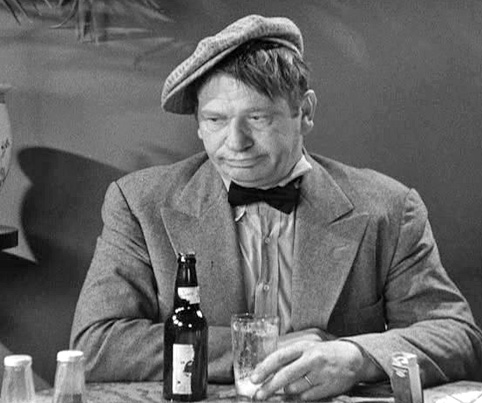
Wallace Beery
A few years prior to the production of Quo Vadis, MGM had undergone a major power shift where dictatorial studio head Louis B. Mayer had been ousted by his thirty-year arch-nemesis, producer Nicholas M. Schenck – a real-life figure who has an offscreen conversation via phone with the also real-life (though heavily fictionalized) Eddie Mannix*.
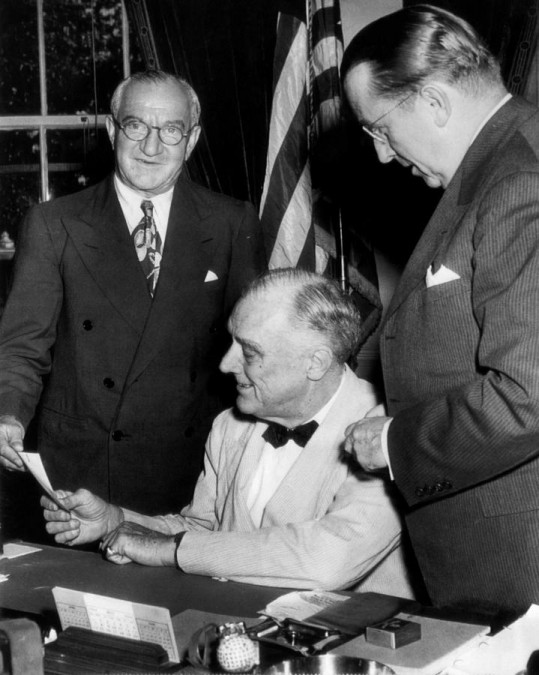
Nicholas M. Schenk (far left) hands check to FDR.
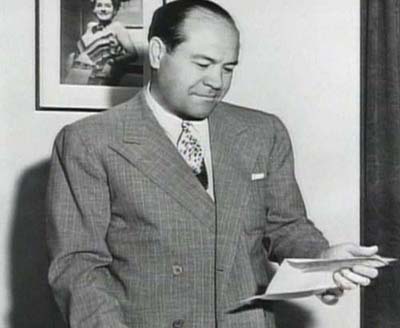
Eddie Mannix
Deafening by his total absence, the Capitol Pictures-simulacrum of MGM chief Louis B. Mayer, Barton Fink‘s bellicose studio head “Jack Lipnick” (Michael Lerner), has obviously since ran afoul of Mannix’s boss Nick Schenck and, as the saying went, has been “kicked down the stairs” to Hollywood-style oblivion (i.e., “retirement”). Together, Hail, Caesar! comically evokes the power (and talent) vacuum of the period that a studio “hatchet man” like Mannix would be brought in to “fix”.
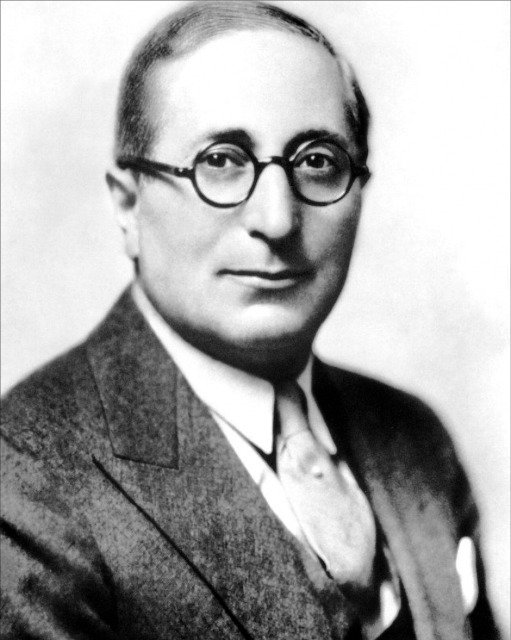
Louis B. Mayer
Rounding out the major roles are reel-life versions of swimming star Esther Williams (“DeeAnna Moran”; Scarlett Johansson), musical star Gene Kelly (“Burt Gurney”; Channing Tatum), rival twins(!) suggesting hat-loving gossip columnist Hedda Hopper (“Thora & Thessaly Thacker”; Tilda Swinton), and a Roy Rogers/Gene Autry/Kirby Grant-style singing cowboy (“Hobie Doyle”; Alden Ehrenreich) – among many others – along with the paternity scandals, sexuality rumors, and cosmetic surgeries that, again, hired guns like Mannix spent their careers covering up. All in aid of preserving the illusion of that business called “show”…
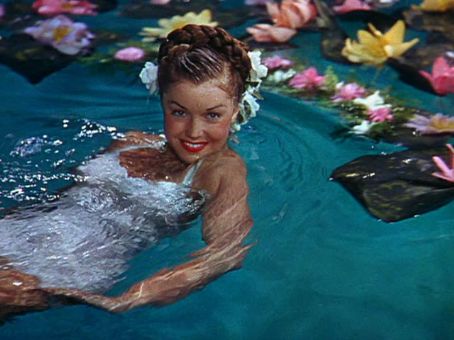
Esther Williams
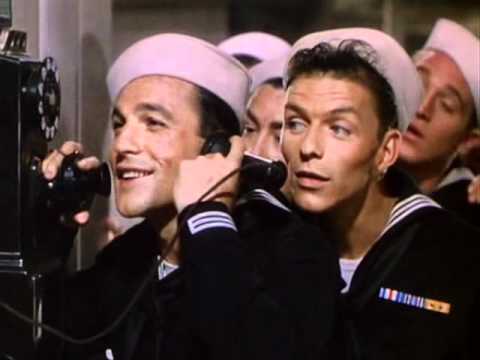
Gene Kelly (flanked by Frank Sinatra)

Roy Rogers

gossip columnist Hedda Hopper
But hey, folks, that’s Hollywood! Ultimately, the backdrop of all these internecine goings-on is largely unimportant to the farcically fictional story the Coens graft on to both real and reel-life Hollywood history. Indeed, what it all adds up to, with the international Communist conspiracy and the Hydrogen Bomb thrown in for good measure, is anyone’s guess, but I was mostly entertained in the not-really-knowing – as, presumably, were those at the showing I attended – and personally spent a rather fun hour and a half marveling at how Hail, Caesar! was ever made in the first place. Famous for their almost defiantly “arch” humor, only Joel & Ethan could pull off constructing an “arch” so narrow that the only ones able to pass successfully through it would be, quite possibly, Joel & Ethan Coen.
…
As such, per our discussion above, a Gene Kelly-alike Crossing the Delaware-ish to meet a Soviet Submarine surfacing near Malibu Beach — while the energetic hoofer in question is being rowed by a hilariously literal screen representation of the Hollywood Ten — is either the Coen Bros. disappearing up their own clever a**es OR represents a career apotheosis for the Brothers Coen they will never top. In the FB comment thread I’m (perhaps awkwardly) adapting this article from, I originally made the point that, here, the Coens seem to be “mythologizing the very Hollywood myths they are referencing” in much the same way that Hollywood “mythologized” Broadway plays, bestsellers, stage musicals, and here, of course, massive Biblical epics. (“A Tale of the Christ!” in big red letters.) So the very plainly apparent “artificiality” of Capitol Picture’s Mississippi Mermaid/Dinner at Eight/Roll in Texas Moon/Anchors Away/Whathaveyou-like productions seems so exaggerated and over-the-top in the Coens’ meticulous recreations – that nonetheless seem somehow “off” – I can’t help feeling the Coens are making some grand point about the “manufactured” quality of Hollywood “product”.

Either that or, even more possibly, the Brothers are laughing at us, their audience, for making such an interpretation. (Or any interpretation, for that matter.) I jokingly sent a text describing Hail, Caesar! as the “most Coen Brothers-y movie the Coen Brothers ever Coen Brothers-ed” and do feel the “shaggy dog” aspect of their work – summed up, basically, as “much ado about nothing in particular, really” – is more pronounced here than in their previous 16 films, even. (Which makes Hail, Caesar!, perhaps, the ultimate Coen Brothers movie.) In the end, though, I’m not really sure one way or the other – and, even after writing over a thousand words on it, remain puzzled by what exactly I enjoyed about Hail, Caesar! – but, whatever the case, in the final analysis I’m glad I live in a world where Joel & Ethan Coen get to make movies.
*UPDATE 2/9: In re-editing the article, I have since learned that Hail, Caesar‘s fictional character of Eddie Mannix is partially based on a real-life MGM studio “fixer” also named “Eddie Mannix”. (I somehow did not connect the name with one of the figures — along with his second wife, Toni Mannix — involved in the mysterious death of actor George Reeves.) Oops.

